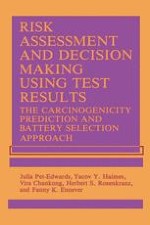1989 | OriginalPaper | Buchkapitel
Applications of CPBS to Cancer Hazard Identification
verfasst von : Julia Pet-Edwards, Yacov Y. Haimes, Vira Chankong, Herbert S. Rosenkranz, Fanny K. Ennever
Erschienen in: Risk Assessment and Decision Making Using Test Results
Verlag: Springer US
Enthalten in: Professional Book Archive
Aktivieren Sie unsere intelligente Suche, um passende Fachinhalte oder Patente zu finden.
Wählen Sie Textabschnitte aus um mit Künstlicher Intelligenz passenden Patente zu finden. powered by
Markieren Sie Textabschnitte, um KI-gestützt weitere passende Inhalte zu finden. powered by
The field of genetic toxicology finds itself at a crossroads. On the one hand, the premise of the somatic mutation theory of cancer, which provides a scientific basis for the development of short-term tests for predicting cancers, has been amply vindicated by the discovery of oncogene activation. On the other hand, however, recent NTP-sponsored studies have cast doubt upon the performance of short-term tests as predictors of carcinogenicity (Tennant et al., 1987). Analysis of the NTP results by the CPBS shows that this is an incorrect conclusion resulting from an oversimplification (Rosenkranz and Ennever, 1988a). Also, it appears that we have no choice but to continue using short-term tests since the other alternatives are (a) not to test but to wait for untoward effects in our exposed human population and (b) to continue relying solely on animal bioassays.
